Age Identification of Farmland Shelterbelt Using Growth Pattern Based on Landsat Time Series Images
Abstract
:1. Introduction
2. Materials
2.1. Study Area
2.2. Landsat Time Series Data Pre-Processing
2.3. Shelterbelt Construction Status Data
2.4. Validation Data
2.4.1. Fractional Coverage of Shelterbelt Data
2.4.2. Shelterbelt Age Data
3. Methods
3.1. Dimidiate Pixel Model Inversion Fractional Coverage
- (1)
- The endmember sample points of vegetation and cropland were selected by visual interpretation on Landsat time series images combined with existing Google Earth Pro historical images and field observation.
- (2)
- The sample points were evenly distributed where cropland did not change from 1984 to 2021. The NDVI of cropland was extracted annually and the mean value was calculated as the endmember value of cropland (NDVIcropland) in each image.
- (3)
- The sample points were evenly distributed in the image of densely distributed (>5 × 5 pixels) patch poplar forests. Since the patchy forest will change over time, the spatial distribution of the sample points was adjusted according to the inter-annual variation, and the NDVI of vegetation was extracted annually and the mean value was calculated as the vegetation endmember value (NDVIveg) of each image.
3.2. Build FCFS Curve of Time Series
3.2.1. Extract FCFS Value
- (1)
- When the SD < 0.05, the shelterbelt structure is regarded as integrity, and all the FCFS values in the maximum waveform sequence are regarded as valid values; m is the total number of pixel sequences of the FCFS.
- (2)
- When the SD >= 0.05, the shelterbelt structure is incomplete (missing). The valid values are the FCFS value greater than the mean value of the maximum waveform sequence, and n is the id number of valid pixel sequences greater than its mean value.
3.2.2. Time Series FCFS Curve Smooth
- (1)
- The positive effect is reflected in the enhancement of the FCFS value, which is mainly reflected in the dense vegetation (forests or grass) near the shelterbelt, so that the FCFS value is significantly higher than that of the nearby years (FCFSij > FCFSij-1 AND FCFSij > FCFSij+1), and this part will form a significant peak value in the time series FCFS curve.
- (2)
- The negative effect is reflected in the weakening of the FCFS value, mainly due to the cover of the cloud (shadows or image missing), which leads to the FCFS value being significantly lower than that of the nearby years (FCFSij < FCFSij-1 AND FCFSij < FCFSij+1). This issue also presents a significant challenge in age identification, resulting in the formation of pronounced valley values within the time series FCFS curve.
3.3. Growth Pattern Division and Age Identification
3.3.1. Determination Initial Recognition Characteristics of Remote Sensing
3.3.2. Growth Pattern Analysis
- (1)
- Pattern one: The shelterbelt existed in the early stage of monitoring, and continuous planting was not interrupted. Renewing occurred during the monitoring time, and the times of renewal were less than two. Figure 7a shows the simulated curve of FCFS for this growth pattern. When the renewal occurs, the FCFS value decreased abruptly and remained at a low value for a continuous period. Based on the existing recorded data, the majority of shelterbelts had experienced only one-time renewal, which was reflected in an abrupt change in the FCFS value. When occurring multiple renewals, there were multiple pronounced abrupt points.
- (2)
- Pattern two: No shelterbelt was planted in the initial stage. After the planning of the shelterbelt project, shelterbelt was planted. Figure 7b is the simulation FCFS curve of this growth pattern. They showed that FCFS value was always at a low value when no shelterbelt was planted in the early stage of growth, and the shelterbelt was gradually recognized in the Landsat over 2–4 years of planting. If an FCFS value equal to 0.15 was used as the threshold for the presence or absence of shelterbelt, the FCFS value was below this threshold until the shelterbelt was planted and recognized.
- (3)
- Pattern three: The shelterbelt existed at the beginning of the monitoring period and did not undergo renewal. When the shelterbelt belonged to this pattern, the value of FCFS was always high; except for the influence of external factors such as cloud and shadow, the overall FCFS value was higher than 0.15 (Figure 7c). The shelterbelt of such growth patterns was all more than 30 years old, focusing on this shelterbelt that needs to be renewed orderly.
3.3.3. Age Identification Based on Growth Pattern
3.4. Accuracy Assessment
4. Results
4.1. Remote Sensing Inversion of FCFS
4.2. Evaluation of Shelterbelt Age Identification Accuracy
4.3. Age Mapping Analysis in the Study Area
5. Discussion
5.1. Analysis of Age Error Sources
- (1)
- Missing remote sensing image and continuous interference from clouds and others. Because of the limitations of the sensors and weather conditions, when shelterbelt images were missed at key time nodes of growth (renewal or initial planting) years or had been affected by clouds or other external influences for several consecutive years, it would cause anomalies in the local FCFS curve. Even if the smoothing method proposed in this paper was used, it was difficult to restore the FCFS curve truly, leading to the incorrect division of the shelterbelt growth pattern, which in turn will result in wrong age identification.
- (2)
- Accuracy of the dimidiate pixel model when applied to the medium resolution remote images (30 m, Landsat) inversion fractional coverage of farmland shelterbelt. The spatial resolution of Landsat series satellite image is 30 m, and the canopy width of farmland shelterbelt is generally between 10 and 30 m, so the images of the shelterbelt are all mixed pixels. Due to the influence of the stand environment, the changes between the shelterbelt and the cropland at the pixel level may not always conform to the linear changes, causing interference to the subsequent FCFS curve.
- (3)
- The characteristics value setting of remote sensing data in the judgment of the growth pattern of shelterbelt. When setting the threshold for the initial recognition of farmland shelterbelt on Landsat, we selected 3 years after planting that could be recognized on the image based on the characteristics of the shelterbelt. Meanwhile, we set the FCFS value greater than 0.15 as the threshold for initial recognition on Landsat. However, due to the influence of the number of rows planted, the spacing between rows, and the time of the available Landsat images, there were fluctuations in the year of initial identification characteristics. Therefore, the uniform setting of a fixed threshold will inevitably lead to misjudgment, affecting the shelterbelt age identification.
5.2. Methods Comparison
6. Conclusions
Author Contributions
Funding
Data Availability Statement
Acknowledgments
Conflicts of Interest
References
- Zhang, H.; Brandle, J.; Meyer, G.; Hodges, L. The relationship between open windspeed and windspeed reduction in shelter. Agrofor. Syst. 1995, 32, 297–311. [Google Scholar] [CrossRef]
- Cleugh, H.; Miller, J.; Böhm, M. Direct mechanical effects of wind on crops. Agrofor. Syst. 1998, 41, 85–112. [Google Scholar] [CrossRef]
- Jiao-jun, Z.; Feng-qi, J.; Takeshi, M. Spacing interval between principal tree windbreaks. J. For. Res. 2002, 13, 83–90. [Google Scholar] [CrossRef]
- Torita, H.; Satou, H. Relationship between shelterbelt structure and mean wind reduction. Agric. For. Meteorol. 2007, 145, 186–194. [Google Scholar] [CrossRef]
- Fang, H.; Aitkenhead, M. Quantifying farmland shelterbelt impacts on catchment soil erosion and sediment yield for the black soil region, northeastern China. Soil Use Manag. 2020, 37, 181–195. [Google Scholar] [CrossRef]
- Smith, M.M.; Bentrup, G.; Kellerman, T.; MacFarland, K.; Straight, R.; Ameyaw, L. Windbreaks in the United States: A systematic review of producer-reported benefits, challenges, management activities and drivers of adoption. Agric. Syst. 2021, 187, 103032. [Google Scholar] [CrossRef]
- Sun, J.; Hamel, J.F.; Gianasi, B.L.; Mercier, A. Correction to: ‘Age determination in echinoderms: First evidence of annual growth rings in holothuroids’ 2022 by Sun et al. Proc. Biol. Sci. 2022, 289, 20221872. [Google Scholar] [CrossRef]
- Ali, A. Forest stand structure and functioning: Current knowledge and future challenges. Ecol. Indic. 2019, 98, 665–677. [Google Scholar] [CrossRef]
- Parker, G.G. Tamm review: Leaf Area Index (LAI) is both a determinant and a consequence of important processes in vegetation canopies. For. Ecol. Manag. 2020, 477, 118496. [Google Scholar] [CrossRef]
- Nascimbene, J.; Marini, L.; Motta, R.; Nimis, P.L. Influence of tree age, tree size and crown structure on lichen communities in mature Alpine spruce forests. Biodivers. Conserv. 2008, 18, 1509–1522. [Google Scholar] [CrossRef]
- Chemura, A.; van Duren, I.; van Leeuwen, L.M. Determination of the age of oil palm from crown projection area detected from WorldView-2 multispectral remote sensing data: The case of Ejisu-Juaben district, Ghana. ISPRS J. Photogramm. Remote Sens. 2015, 100, 118–127. [Google Scholar] [CrossRef]
- Chen, B.; Cao, J.; Wang, J.; Wu, Z.; Tao, Z.; Chen, J.; Yang, C.; Xie, G. Estimation of rubber stand age in typhoon and chilling injury afflicted area with Landsat TM data: A case study in Hainan Island, China. For. Ecol. Manag. 2012, 274, 222–230. [Google Scholar] [CrossRef]
- Trisasongko, B.H. Mapping stand age of rubber plantation using ALOS-2 polarimetric SAR data. Eur. J. Remote Sens. 2017, 50, 64–76. [Google Scholar] [CrossRef]
- Racine, E.B.; Coops, N.C.; St-Onge, B.; Bégin, J. Estimating Forest Stand Age from LiDAR-Derived Predictors and Nearest Neighbor Imputation. For. Sci. 2014, 60, 128–136. [Google Scholar] [CrossRef]
- Kacic, P.; Kuenzer, C. Forest Biodiversity Monitoring Based on Remotely Sensed Spectral Diversity—A Review. Remote Sens. 2022, 14, 5363. [Google Scholar] [CrossRef]
- Dye, M.; Mutanga, O.; Ismail, R. Combining spectral and textural remote sensing variables using random forests: Predicting the age of Pinus patula forests in KwaZulu-Natal, South Africa. J. Spat. Sci. 2012, 57, 193–211. [Google Scholar] [CrossRef]
- Cohen, W.B.; Spies, T.A.; Fiorella, M. Estimating the age and structure of forests in a multi-ownership landscape of western Oregon, U.S.A. Int. J. Remote Sens. 1995, 16, 721–746. [Google Scholar] [CrossRef]
- Jensen, J.R.; Qiu, F.; Ji, M.H. Predictive modelling of coniferous forest age using statistical and artificial neural network approaches applied to remote sensor data. Int. J. Remote Sens. 1999, 20, 2805–2822. [Google Scholar]
- Kennedy, R.E.; Yang, Z.; Cohen, W.B. Detecting trends in forest disturbance and recovery using yearly Landsat time series: 1. LandTrendr—Temporal segmentation algorithms. Remote Sens. Environ. 2010, 114, 2897–2910. [Google Scholar] [CrossRef]
- Huang, C.; Goward, S.N.; Masek, J.G.; Gao, F.; Vermote, E.F.; Thomas, N.; Schleeweis, K.; Kennedy, R.E.; Zhu, Z.; Eidenshink, J.C.; et al. Development of time series stacks of Landsat images for reconstructing forest disturbance history. Int. J. Digit. Earth 2009, 2, 195–218. [Google Scholar] [CrossRef]
- Broich, M.; Hansen, M.C.; Potapov, P.; Adusei, B.; Lindquist, E.; Stehman, S.V. Time-series analysis of multi-resolution optical imagery for quantifying forest cover loss in Sumatra and Kalimantan, Indonesia. Int. J. Appl. Earth Obs. Geoinf. 2011, 13, 277–291. [Google Scholar] [CrossRef]
- Shen, Z.; Wang, Y.; Su, H.; He, Y.; Li, S. A bi-directional strategy to detect land use function change using time-series Landsat imagery on Google Earth Engine: A case study of Huangshui River Basin in China. Sci. Remote Sens. 2022, 5, 100039. [Google Scholar] [CrossRef]
- Li, Z.; Fox, J.M. Mapping rubber tree growth in mainland Southeast Asia using time-series MODIS 250 m NDVI and statistical data. Appl. Geogr. 2012, 32, 420–432. [Google Scholar] [CrossRef]
- Fujiki, S.; Okada, K.-I.; Nishio, S.; Kitayama, K. Estimation of the stand ages of tropical secondary forests after shifting cultivation based on the combination of WorldView-2 and time-series Landsat images. ISPRS J. Photogramm. Remote Sens. 2016, 119, 280–293. [Google Scholar] [CrossRef]
- Chen, G.; Thill, J.-C.; Anantsuksomsri, S.; Tontisirin, N.; Tao, R. Stand age estimation of rubber (Hevea brasiliensis) plantations using an integrated pixel- and object-based tree growth model and annual Landsat time series. ISPRS J. Photogramm. Remote Sens. 2018, 144, 94–104. [Google Scholar] [CrossRef]
- Deng, R.; Xu, Z.; Li, Y.; Zhang, X.; Li, C.; Zhang, L. Farmland Shelterbelt Age Mapping Using Landsat Time Series Images. Remote Sens. 2022, 14, 1457. [Google Scholar] [CrossRef]
- Hanjie, W. A simulation study on the eco-environmental effects of 3N Shelterbelt in North China. Glob. Planet. Chang. 2003, 37, 231–246. [Google Scholar] [CrossRef]
- Zeng, H.; Peltola, H.; Väisänen, H.; Kellomäki, S. The effects of fragmentation on the susceptibility of a boreal forest ecosystem to wind damage. For. Ecol. Manag. 2009, 257, 1165–1173. [Google Scholar] [CrossRef]
- Wang, H.; Takle, E.S. Model-simulated influences of shelterbelt shape on wind-sheltering efficiency. J. Appl. Meteorol. Climatol. 1997, 36, 695–704. [Google Scholar] [CrossRef]
- Song, C.; Woodcock, C.E.; Seto, K.C.; PaxLenney, M.; Macomber, S.A. Classification and Change Detection Using Landsat TM Data: When and How to Correct Atmospheric Effects? Remote Sens. Environ. 2001, 75, 230–244. [Google Scholar] [CrossRef]
- Roy, D.P.; Wulder, M.A.; Loveland, T.R.; Woodcock, C.E.; Allen, R.G.; Anderson, M.C.; Helder, D.; Irons, J.R.; Johnson, D.M.; Kennedy, R.; et al. Landsat-8: Science and product vision for terrestrial global change research. Remote Sens. Environ. 2014, 145, 154–172. [Google Scholar] [CrossRef]
- Schäfer, K.; Perkins, T.; Comerón, A.; Adler-Golden, S.; Matthew, M.; Slusser, J.R.; Picard, R.H.; Berk, A.; Anderson, G.; Carleer, M.R.; et al. Retrieval of atmospheric properties from hyper and multispectral imagery with the FLAASH atmospheric correction algorithm. In Remote Sensing of Clouds and the Atmosphere X; SPIE: Bellingham, WA, USA, 2005. [Google Scholar]
- Shen, S.S.; Felde, G.W.; Lewis, P.E.; Anderson, G.P.; Gardner, J.A.; Adler-Golden, S.M.; Matthew, M.W.; Berk, A. Water vapor retrieval using the FLAASH atmospheric correction algorithm. In Algorithms and Technologies for Multispectral, Hyperspectral, and Ultraspectral Imagery X; SPIE: Bellingham, WA, USA, 2004. [Google Scholar]
- Rouse, J., Jr.; Haas, R.H.; Deering, D.; Schell, J.; Harlan, J.C. Monitoring the Vernal Advancement and Retrogradation (Green Wave Effect) of Natural Vegetation. 1974. Available online: https://ntrs.nasa.gov/api/citations/19730017588/downloads/19730017588.pdf (accessed on 15 November 2022).
- Woebbecke, D.M.; Meyer, G.E.; Von Bargen, K.; Mortensen, D.A. Color Indices for Weed Identification Under Various Soil, Residue, and Lighting Conditions. Trans. ASAE 1995, 38, 259–269. [Google Scholar] [CrossRef]
- Li, L.; Mu, X.; Macfarlane, C.; Song, W.; Chen, J.; Yan, K.; Yan, G. A half-Gaussian fitting method for estimating fractional vegetation cover of corn crops using unmanned aerial vehicle images. Agric. For. Meteorol. 2018, 262, 379–390. [Google Scholar] [CrossRef]
- Torres-Sanchez, J.; Pena, J.M.; de Castro, A.I.; Lopez-Granados, F. Multi-temporal mapping of the vegetation fraction in early-season wheat fields using images from UAV. Comput. Electron. Agric. 2014, 103, 104–113. [Google Scholar] [CrossRef]
- Gao, L.; Wang, X.; Johnson, B.A.; Tian, Q.; Wang, Y.; Verrelst, J.; Mu, X.; Gu, X. Remote sensing algorithms for estimation of fractional vegetation cover using pure vegetation index values: A review. ISPRS J. Photogramm. Remote Sens. 2020, 159, 364–377. [Google Scholar] [CrossRef]
- Deng, R.-X.; Wang, W.-J.; Li, Y.; Zhao, D.-B. A retrieval and validation method for shelterbelt vegetation fraction. J. For. Res. 2013, 24, 357–360. [Google Scholar] [CrossRef]
- Jiang, Z.; Huete, A.R.; Chen, J.; Chen, Y.; Li, J.; Yan, G.; Zhang, X. Analysis of NDVI and scaled difference vegetation index retrievals of vegetation fraction. Remote Sens. Environ. 2006, 101, 366–378. [Google Scholar] [CrossRef]
- Xiao, J.F.; Moody, A. A comparison of methods for estimating fractional green vegetation cover within a desert-to-upland transition zone in central New Mexico, USA. Remote Sens. Environ. 2005, 98, 237–250. [Google Scholar] [CrossRef]
- Yan, K.; Gao, S.; Chi, H.; Qi, J.; Song, W.; Tong, Y.; Mu, X.; Yan, G. Evaluation of the Vegetation-Index-Based Dimidiate Pixel Model for Fractional Vegetation Cover Estimation. IEEE Trans. Geosci. Remote Sens. 2022, 60, 4400514. [Google Scholar] [CrossRef]
- Deng, R.X.; Li, Y.; Wang, W.J.; Zhang, S.W. Recognition of shelterbelt continuity using remote sensing and waveform recognition. Agrofor. Syst. 2013, 87, 827–834. [Google Scholar] [CrossRef]
- Townshend, J.R.G.; Justice, C.O. Spatial variability of images and the monitoring of changes in the Normalized Difference Vegetation Index. Int. J. Remote Sens. 2007, 16, 2187–2195. [Google Scholar] [CrossRef]
- Zhu, J.; Jiang, F.; Zeng, D. Phase-directional management of protective plantations. II. Typical protective plantation: Farmland shelterbelt. J. Appl. Ecol. 2002, 13, 1273–1277. [Google Scholar]
- Fewin, R.J.; Helwig, L. Windbreak renovation in the American great plains. Agric. Ecosyst. Environ. 1988, 22, 571–582. [Google Scholar] [CrossRef]
- Peri, P.L.; Bloomberg, M. Windbreaks in southern Patagonia, Argentina: A review of research on growth models, windspeed reduction, and effects oncrops. Agrofor. Syst. 2002, 56, 129–144. [Google Scholar] [CrossRef]
- Deng, R.; Yang, G.; Li, Y.; Xu, Z.; Zhang, X.; Zhang, L.; Li, C. Identification of shelterbelt width from high-resolution remote sensing imagery. Agrofor. Syst. 2022, 96, 1091–1101. [Google Scholar] [CrossRef]
- Deng, R.X.; Li, Y.; Xu, X.L.; Wang, W.J.; Wei, Y.C. Remote estimation of shelterbelt width from SPOT5 imagery. Agrofor. Syst. 2016, 91, 161–172. [Google Scholar] [CrossRef]
- Fensholt, R.; Rasmussen, K.; Nielsen, T.T.; Mbow, C. Evaluation of earth observation based long term vegetation trends—Intercomparing NDVI time series trend analysis consistency of Sahel from AVHRR GIMMS, Terra MODIS and SPOT VGT data. Remote Sens. Environ. 2009, 113, 1886–1898. [Google Scholar] [CrossRef]
- Chen, J.; Jonsson, P.; Tamura, M.; Gu, Z.H.; Matsushita, B.; Eklundh, L. A simple method for reconstructing a high-quality NDVI time-series data set based on the Savitzky-Golay filter. Remote Sens. Environ. 2004, 91, 332–344. [Google Scholar] [CrossRef]
- Yang, Z.; Liu, Q.; Luo, P.; Ye, Q.; Duan, G.; Sharma, R.P.; Zhang, H.; Wang, G.; Fu, L. Prediction of Individual Tree Diameter and Height to Crown Base Using Nonlinear Simultaneous Regression and Airborne LiDAR Data. Remote Sens. 2020, 12, 2238. [Google Scholar] [CrossRef]
- Yang, X.; Liu, Y.; Wu, Z.; Yu, Y.; Li, F.; Fan, W. Forest age mapping based on multiple-resource remote sensing data. Environ. Monit. Assess 2020, 192, 734. [Google Scholar] [CrossRef]
- Marais, Z.E.; Baker, T.P.; Hunt, M.A.; Mendham, D. Shelterbelt species composition and age determine structure: Consequences for ecosystem services. Agric. Ecosyst. Environ. 2022, 329, 107884. [Google Scholar] [CrossRef]
- Camarretta, N.; Harrison, P.A.; Bailey, T.; Potts, B.; Lucieer, A.; Davidson, N.; Hunt, M. Monitoring forest structure to guide adaptive management of forest restoration: A review of remote sensing approaches. New For. 2019, 51, 573–596. [Google Scholar] [CrossRef]
- Wiseman, G.; Kort, J.; Walker, D. Quantification of shelterbelt characteristics using high-resolution imagery. Agric. Ecosyst. Environ. 2009, 131, 111–117. [Google Scholar] [CrossRef]
- Suratman, M.N.; Bull, G.Q.; Leckie, D.G.; Lemay, V.M.; Marshall, P.L.; Mispan, M.R. Prediction models for estimating the area, volume, and age of rubber (Hevea brasiliensis) plantations in Malaysia using Landsat TM data. Int. For. Rev. 2004, 6, 1–12. [Google Scholar] [CrossRef]
- Li, X.; Gong, P.; Liang, L. A 30-year (1984–2013) record of annual urban dynamics of Beijing City derived from Landsat data. Remote Sens. Environ. 2015, 166, 78–90. [Google Scholar] [CrossRef]
- Zheng, X.; Zhu, J.; Xing, Z. Assessment of the effects of shelterbelts on crop yields at the regional scale in Northeast China. Agric. Syst. 2016, 143, 49–60. [Google Scholar] [CrossRef]
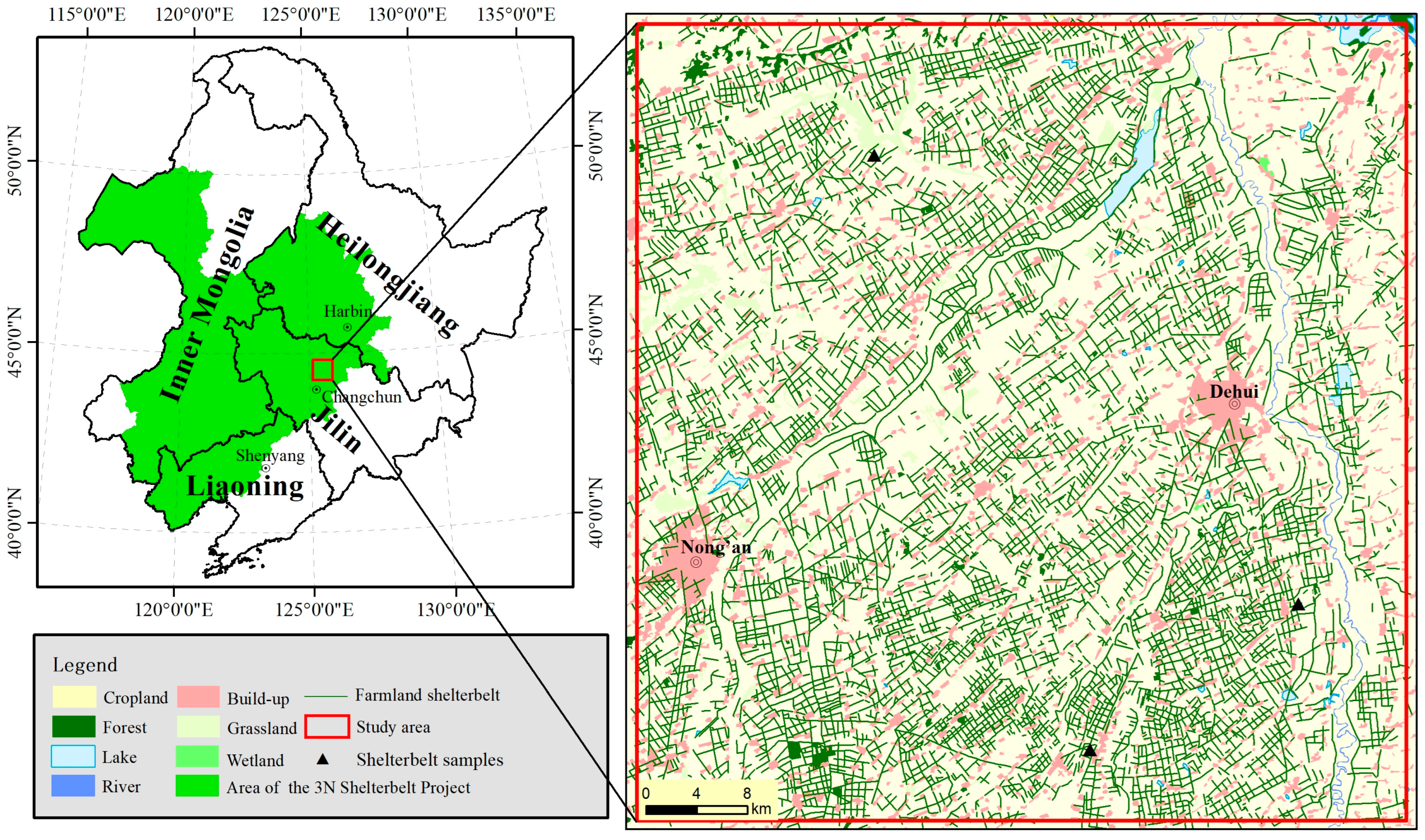
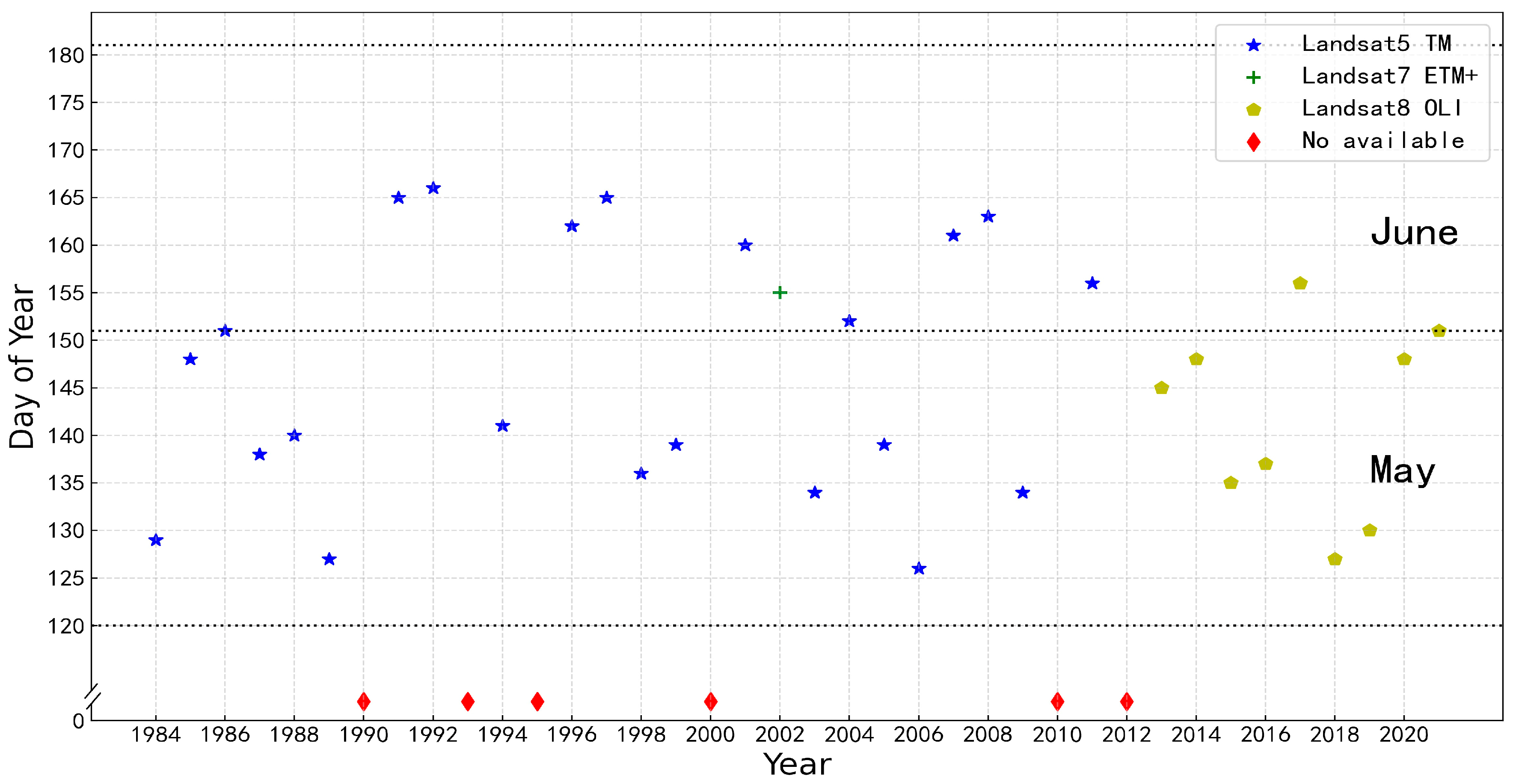
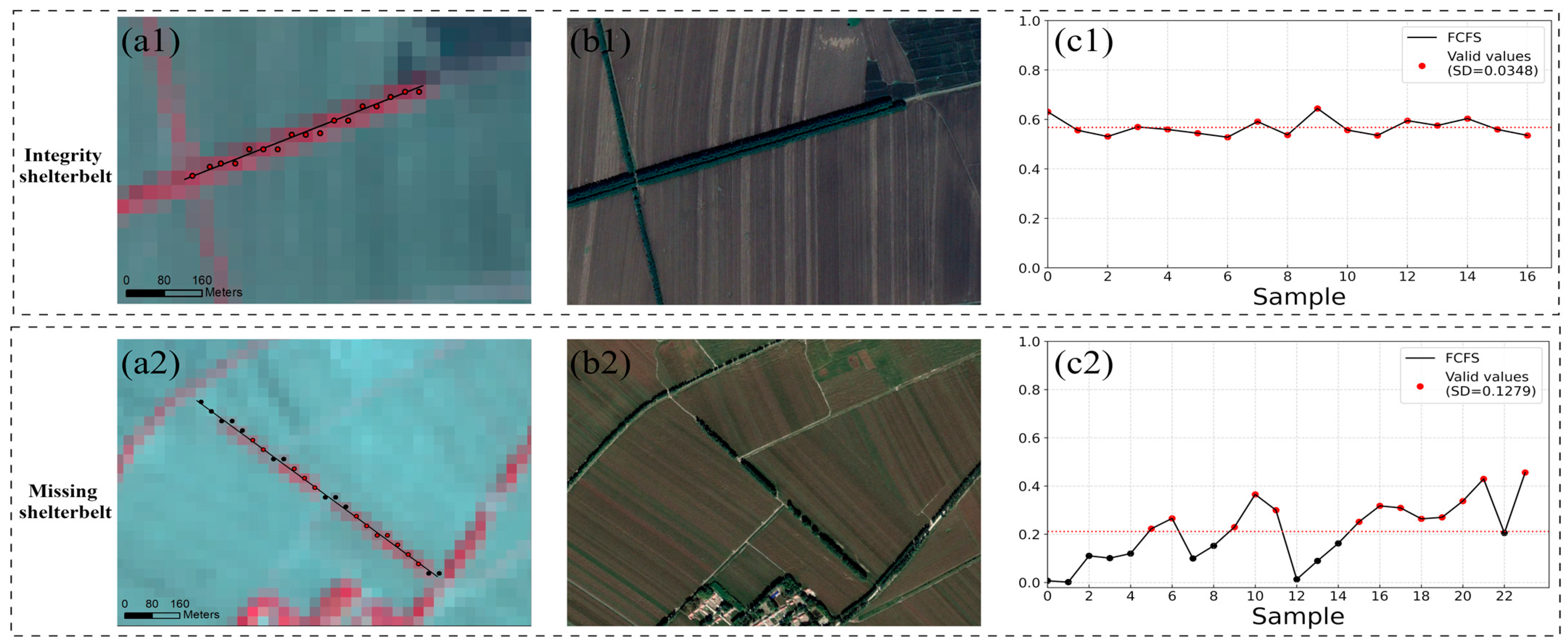
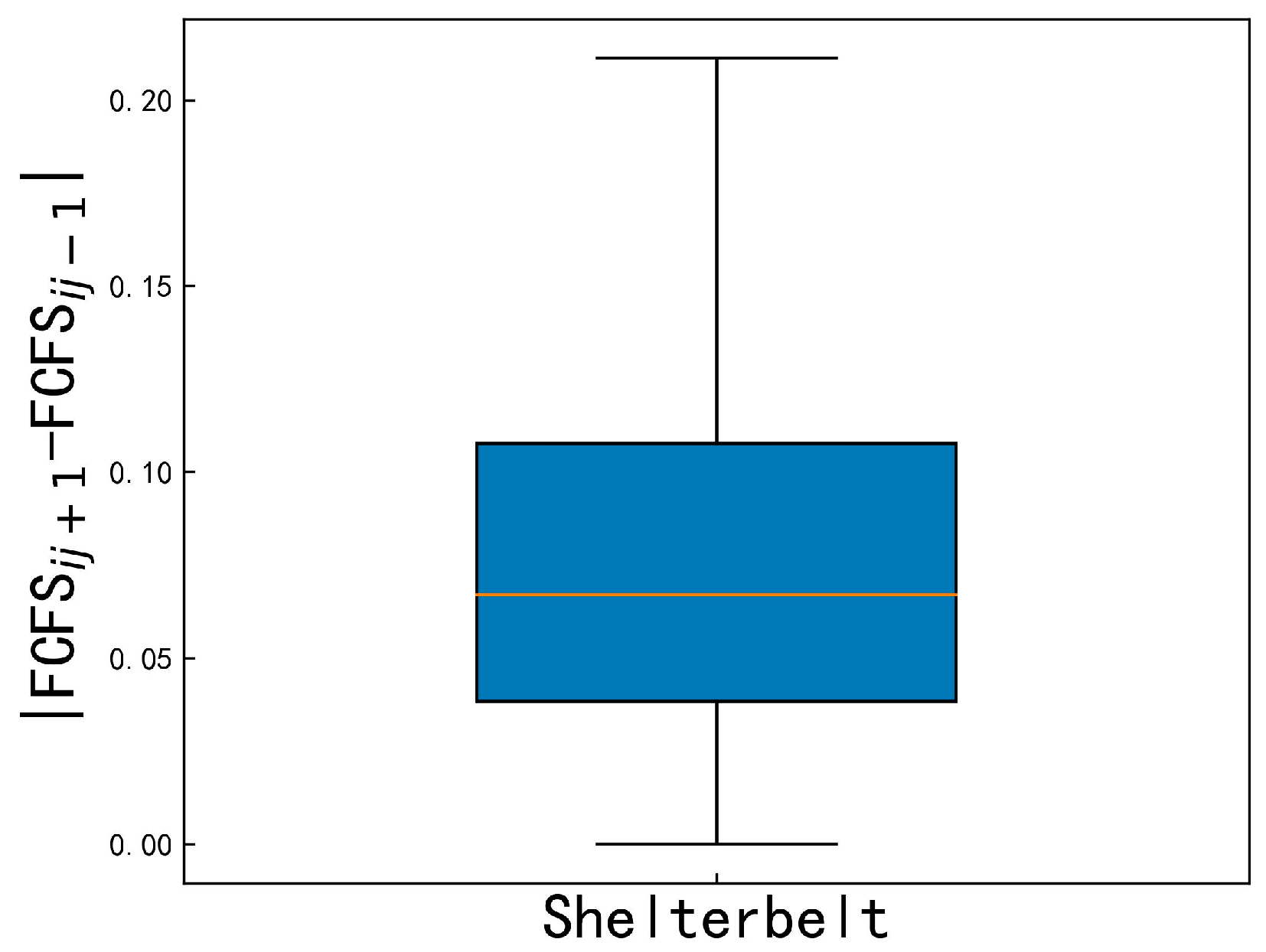
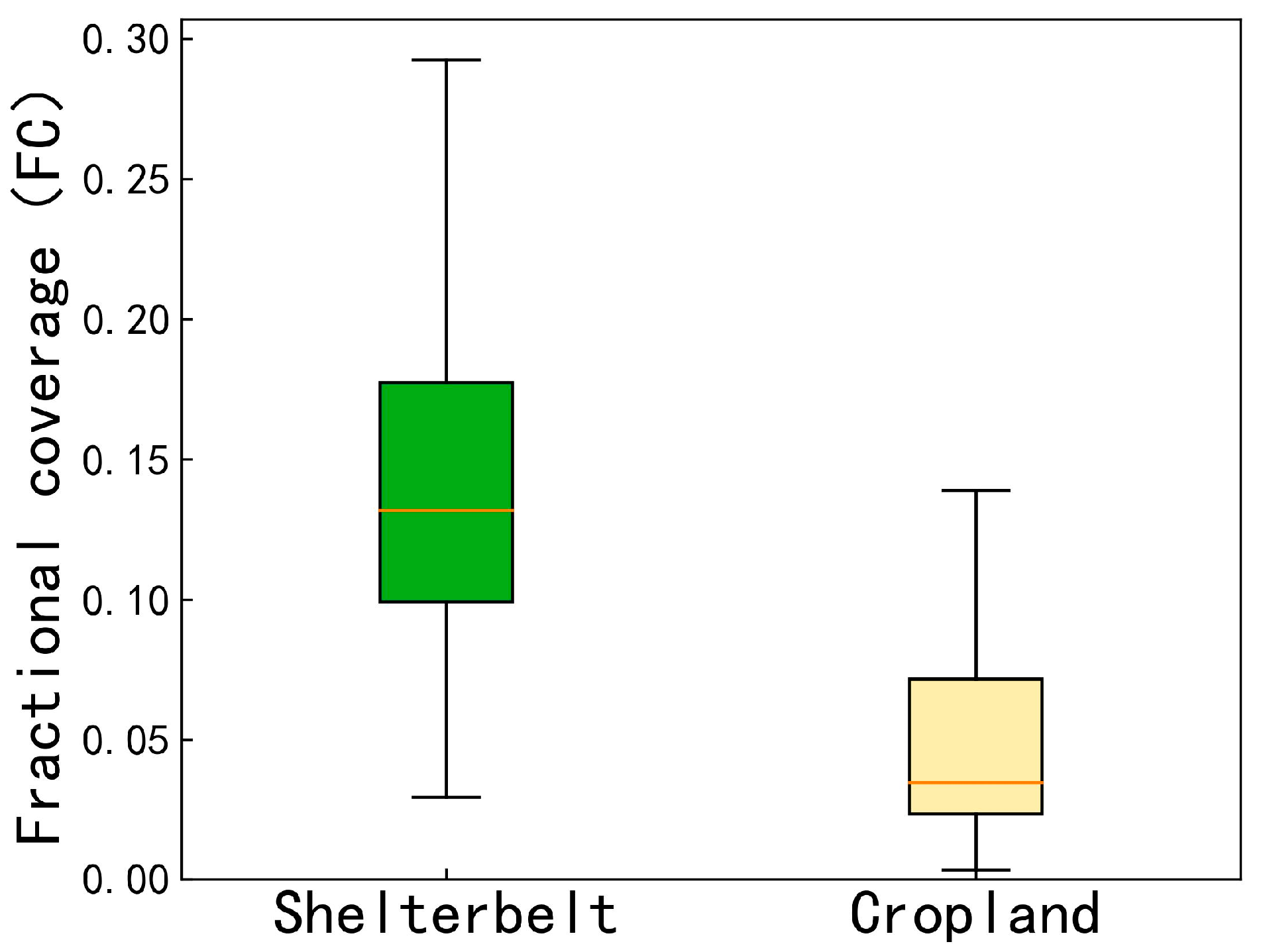
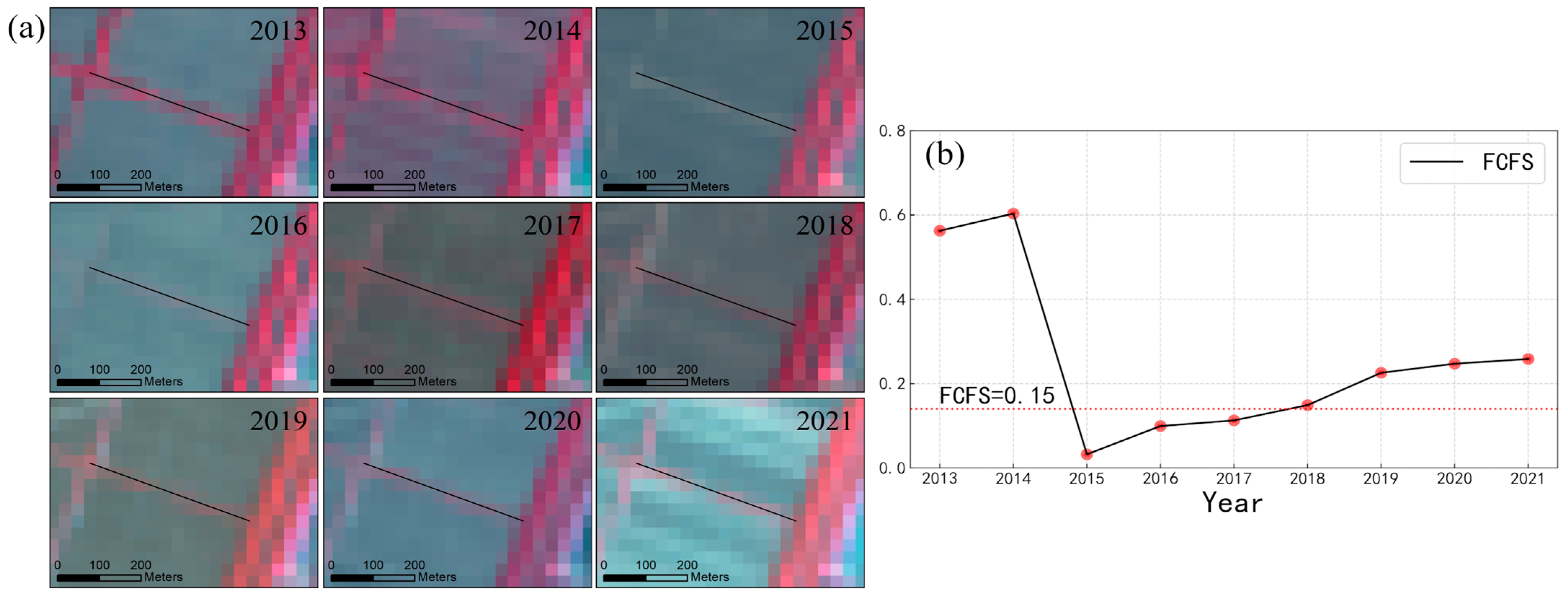


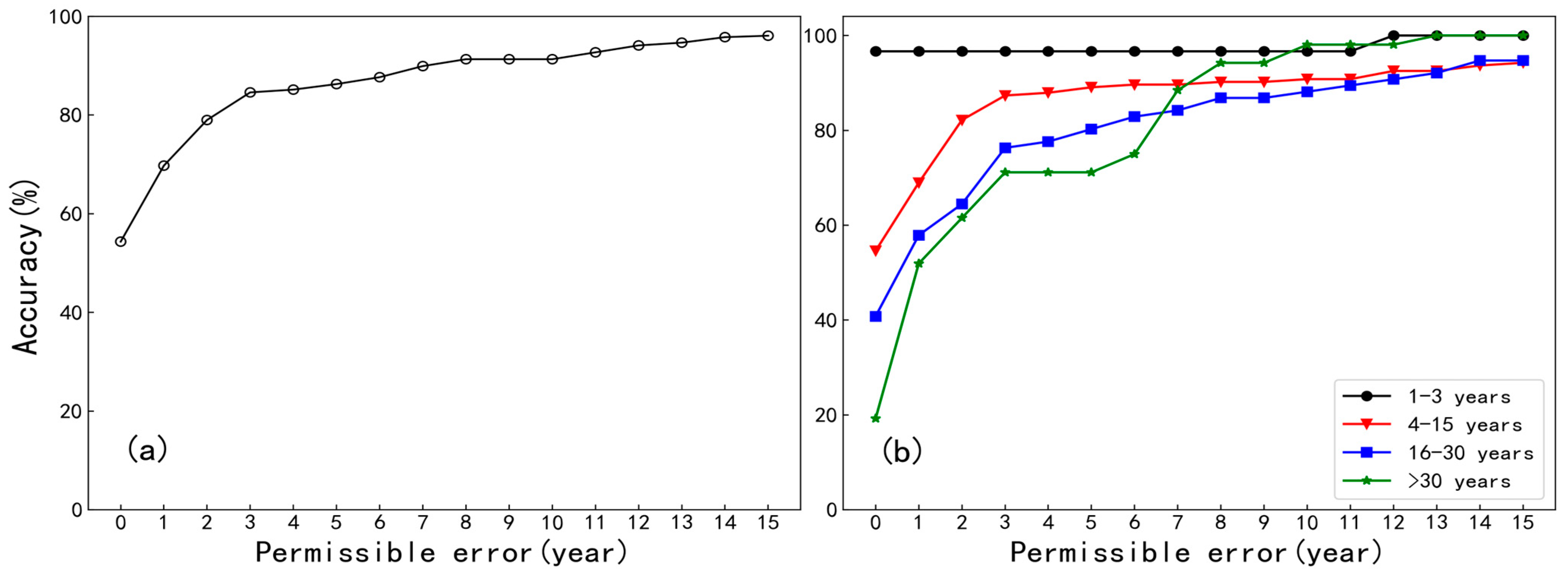
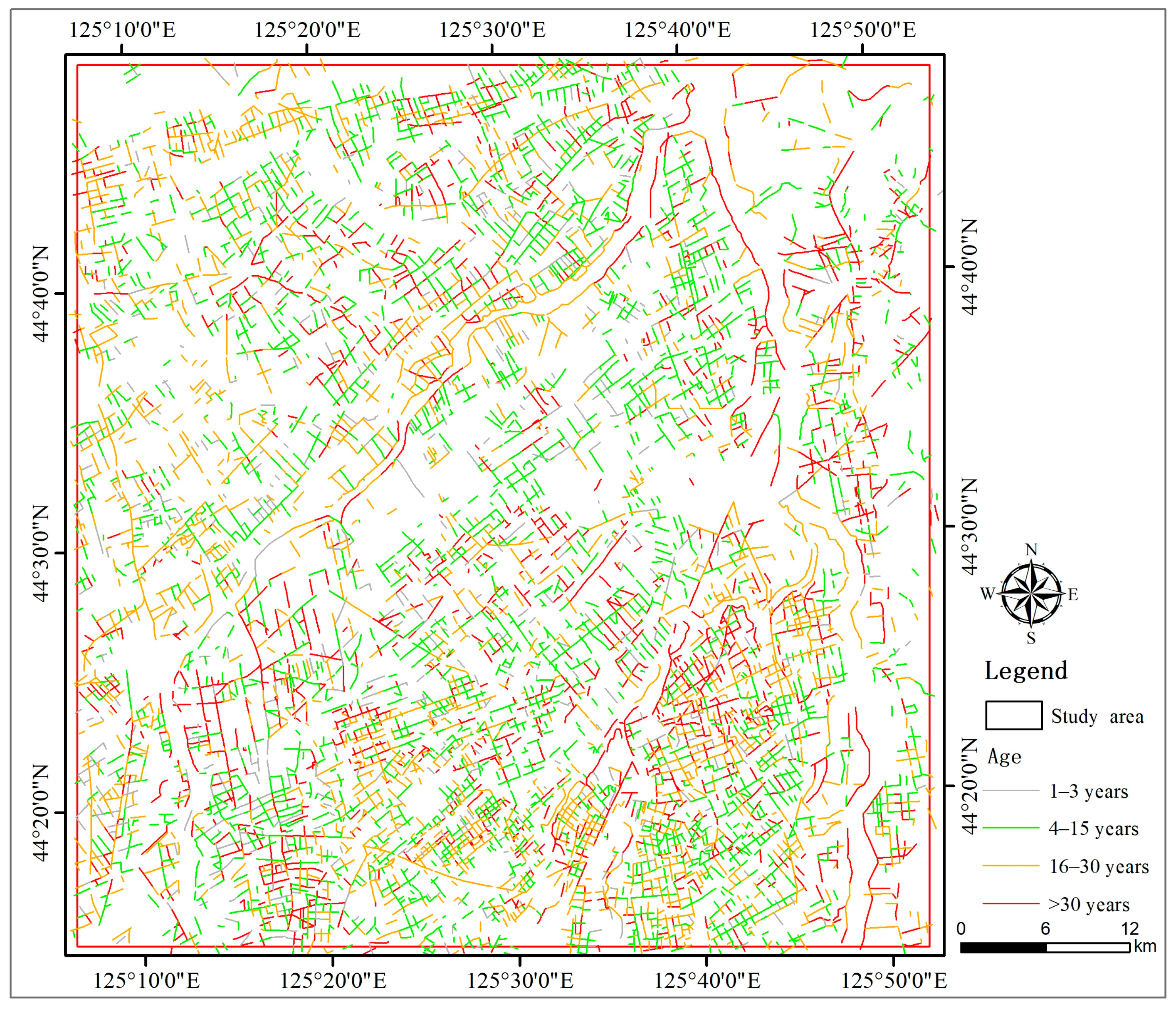

| Truth Age | |||||||
|---|---|---|---|---|---|---|---|
| Phases | 1–3 Years | 4–15 Years | 16–30 Years | >30 Years | Total | Commission | |
| Extracted age | 1–3 years | 59 | 6 | 5 | 0 | 70 | 0.1571 |
| 4–15 years | 1 | 151 | 6 | 0 | 158 | 0.0443 | |
| 16–30 years | 0 | 13 | 64 | 17 | 94 | 0.3191 | |
| >30 years | 0 | 4 | 1 | 30 | 35 | 0.1428 | |
| Total | 60 | 174 | 76 | 47 | 357 | ||
| Omission | 0.0166 | 0.1321 | 0.1578 | 0.3617 | |||
Disclaimer/Publisher’s Note: The statements, opinions and data contained in all publications are solely those of the individual author(s) and contributor(s) and not of MDPI and/or the editor(s). MDPI and/or the editor(s) disclaim responsibility for any injury to people or property resulting from any ideas, methods, instructions or products referred to in the content. |
© 2023 by the authors. Licensee MDPI, Basel, Switzerland. This article is an open access article distributed under the terms and conditions of the Creative Commons Attribution (CC BY) license (https://creativecommons.org/licenses/by/4.0/).
Share and Cite
Zhang, X.; Li, J.; Li, Y.; Deng, R.; Yang, G.; Tang, J. Age Identification of Farmland Shelterbelt Using Growth Pattern Based on Landsat Time Series Images. Remote Sens. 2023, 15, 4750. https://doi.org/10.3390/rs15194750
Zhang X, Li J, Li Y, Deng R, Yang G, Tang J. Age Identification of Farmland Shelterbelt Using Growth Pattern Based on Landsat Time Series Images. Remote Sensing. 2023; 15(19):4750. https://doi.org/10.3390/rs15194750
Chicago/Turabian StyleZhang, Xing, Jieling Li, Ying Li, Rongxin Deng, Gao Yang, and Jing Tang. 2023. "Age Identification of Farmland Shelterbelt Using Growth Pattern Based on Landsat Time Series Images" Remote Sensing 15, no. 19: 4750. https://doi.org/10.3390/rs15194750




